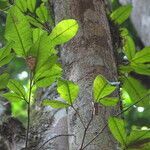Shrub or small, evergreen tree, up to 6 m high. Leaves alternate, 3-foliolate, gland-dotted; leaflets elliptic to obovate, 35-100 x 10-40 mm, sessile, base tapering, apex rounded, margins entire; petioles sometimes narrowly winged. Flowers unisexual in axillary, unbranched sprays. Calyx usually shortly 4-or 5-lobed, cupular. Petals 4 or 5. Male flowers: stamens as many as petals, inserted at base of disc, anthers dorsifixed, cordate, without apical gland; ovary rudimentary. Female flowers: staminodes as many as petals; disc sometimes present; ovary sessile, globose, 1-locular, with 2 pendulous ovules; style short or cylindric; stigma peltate. Flowering time Sept.-Nov. Fruit drupaceous, 1-seeded.




